Ramses Core overview
This page provides an overview of the Ramses C++ API, primary object types, structure and interaction.
Note
Prefer learning by example? Jump straight to the examples! Looking for a specific class or method? Check the class index
RAMSES consists of three logical components:
client (creates and publishes 3D content)
renderer (consumes and displays)
daemon (global address broker, exchanges connection info between clients and renderers in case the underlying communication is TCP)
These components can be deployed as separate applications and communicate over network, or can be all used in a local rendering setup (within a monolithic application) - or in various hybrid combinations.
The Client component
Clients create scenes and manage their content, but cannot decide if and where a scene is shown (similar to a video stream which provides the video, but anyone can subscribe to it). The following subsections provide details on the various aspects of the client API.
Object scopes
Objects of the RAMSES Client API live in different scopes, which determine
who creates the object
where this objects can be used
who destroys the object (and when)
Scope: :class:`ramses::RamsesClient` Instance
Objects are created and destroyed with the
ramses::RamsesClientobjectExamples for client objects: Scene, Client resources (immutable Textures, Vertex arrays, Effects…)
On destruction of
ramses::RamsesClient, objects of thisramses::RamsesClientinstance will be deleted automaticallyTo destroy objects created by
ramses::RamsesClient, one must explicitly callramses::RamsesClient::destroy()Object of this scope can be used for all operations in this
ramses::RamsesClientinstance.
Scope: :class:`ramses::Scene` Instance
Objects are created and destroyed with the Scene object
Examples for scene objects:
ramses::Node,ramses::MeshNode,ramses::Camera,ramses::Appearance, …On destruction of Scene, objects in this Scene instance will be deleted automatically
To destroy objects created by Scene, one must explicitly call
ramses::Scene::destroy()Objects of this scene instance can be used only with objects of the same scene instance
Mixing up objects of different scene instances will result in error status or undefined behaviour (e.g. setting a parent-child relationship between nodes of different scenes; see Validation)
API Object lifecycle
Object lifecycle is an important topic in any C++ framework. In the case of Ramses,
creation and destruction is strict, straightforward and simple,
but leaves the responsibility of object deletion in some cases to the user.
As described in the Scopes chapter, the ownership of objects is defined by their scope.
A ramses::MeshNode is owned by a ramses::Scene, which is owned by a ramses::RamsesClient. If a RamsesClient
is destroyed, all of its scenes will be destroyed automatically, which in turn will
destroy the MeshNodes in those scenes and so on. This implicit destruction done by
RAMSES is limited to this case only, ie. when the ‘owner’ is destroyed then all the
objects created within this owner are destroyed and any pointers to those become invalid.
There is no reference counting of any sort therefore RAMSES will not automatically destroy an object if it is not used by any other object and therefore user is responsible for destroying unused content to free up resources. Creation and destruction of objects can cause performance hit on both client and renderer so it is recommended to consider some caching strategy on the application side.
Resources
There are 3 main types of resources in RAMSES
Immutable client resources (texture, index/vertex buffer, effect)
Scene resources (render buffer/target, stream texture, blit pass)
Dynamic resources (data buffer, texture buffer)
These resource types differ by how are they created, owned and used for rendering a scene. Here are some basic rules for when to use which type:
A typical use case for an immutable client resource is any resource that is created once and does not need to be changed for a reasonably long period of time. A client resource can be used by multiple scenes as it is owned by a RAMSES client instance and is typically transferred asynchronously (see below). Client resources are designed to efficiently handle large data and thus are best fit for static textures.
A scene resource represents some kind of GPU buffer (render buffer/target, stream texture) or a rendering construct (blit pass). A scene resource has no initial user provided data and its usage is clearly defined by the concrete type. Scene resources are created and owned by a scene and can be used only within that scene, not across scenes as opposed to client resources.
The content of a dynamic resource is set by user and can be modified directly at any time during its life cycle via RAMSES API. Even though the concrete types overlap with some of the concrete types of client resource (index/vertex buffer, texture), the way dynamic resources are handled in RAMSES is in fact closer to scene resources. Similar to a scene resource a dynamic resource is created and owned by a scene and can be used only within that scene. A typical use case is a resource that frequently changes (even if only partially). Dynamic resources should be kept small as they are processed synchronously together with other scene state changes.
Asynchronous processing of client resources
One important aspect of RAMSES, which is different from most other scene graph implementations, is the fact that immutable client resources (Textures, Effects, Vertex arrays etc.) are distributed asynchronously. This means that it might happen that a scene arrived on the renderer, but some of its resources are still on the way and it will take more time until all the resources are uploaded and ready for rendering. This is true also if the renderer<->client communication is in the same process. Resources are usually big and would block the entire rendering chain if they were transported/uploaded synchronously to the rest of the scene objects.
The renderer always waits with the next content change (scene flush) until it has all the resources needed for the new scene content state. Note that this does not affect framerate on renderer side, the renderer will simply keep rendering the old state of the scene until it receives all the resources required for the new state. But it can delay the changes made in that flush as they are ‘blocked’ until all the resources are resolved.
API error handling
The RAMSES API is designed to check most errors on usage - for example trying to create ramses::TextureSampler using a write-only
ramses::RenderBuffer will result in error.
In case of an error the API method returns nullptr or false depending on its signature and the error message will appear in log.
For most API calls the error message and object that caused it can also be retrieved by calling ramses::RamsesFramework::getLastError(),
note that only last error that occurred is available this way and it will be cleared after the method is called.
It is highly recommended to check the status of every RAMSES API call, at least in debug configuration. See Validation to find out other ways of checking the state of RAMSES objects.
Validation
Some of the content issues are too expensive to be handled by the normal return code of the Ramses API. Examples of such cases include:
invalid states are very expensive to check, or…
valid states which probably do not produce the desired result
are wasting system resources: eg. having an empty
ramses::RenderPasswhich is being cleared every frame
Another good example of an invalid state is a cyclic dependency on the node graph. If one creates three nodes A, B, C and sets following parent-child dependencies:
A->B
B->C
C->A
This is not an error that RAMSES checks, because it is very expensive to traverse the whole scene graph every time a new node is added as a child of another node.
For development purposes, there are other means to check the state of the scene(s) and understand why the resulting image is not as expected.
Client side validation
The state of any RAMSES object can be checked at any time by calling ramses::RamsesObject::validate() method on its instance.
The ramses::RamsesObject::validate() method returns ramses::ValidationReport which contains list of issues that were found
for the instance that was validated as well as its dependent objects (e.g. ramses::Appearance validates also its assigned ramses::Effect
which is its dependency). Typical use case can be validating a ramses::Scene which will validate all its contents.
The returned ramses::ValidationReport provides list of issues - each containing severity (warning or error), human readable message describing
the issue and pointer to an object that reported this issue. This allows filtering and sorting to suit any concrete needs of the caller (e.g. only
issues of certain object can be filtered).
It is also possible to call validate from the shell. For that, one must enable the
shell by calling ramses::RamsesFrameworkConfig::setRequestedRamsesShellType().
It is also possible to call validate over the so called DLT injections.
To do so, send the validate command to shell context “RMSH” and select service port 5000
(WARNING this may be different based on DLT implementation).
Examples:
# prints validation report for scene with id 15
validate 15
# prints validation report for object with name "MyMesh" from scene with id 15
validate 15 info MyMesh
Renderer side validation
The RAMSES client has a very rich information about a scene - it knows the names of objects, it has detailed scenegraph information. The renderer, however, does not necessarily have all this information (the reason for that is that data sent over network to the renderer must be kept very minimal).
There can be a case when a scene is in valid state on the client (according to validation described above),
but it is not rendered in the the desired way. Such cases can be
difficult to analyze. One simple tool to show the state of the renderer
and get an overview of what is being rendered is to the “rinfo” shell command (only available on a renderer).
While ramses::RamsesObject::validate() focuses on scene content, the purpose of “rinfo” is to get
overview of how is that content interpreted. It reports all the information about displays, scenes it knows
and their states, more or less detailed rendering queue for each shown scene and so on.
Examples:<br>
# prints everything that the renderer knows<br>
rinfo
# prints usage of all ramses shell commands, including rinfo command<br>
help
# prints only errors from embedded compositor, and verbose_mode=true<br>
rinfo error -v ec
As with validate, it is possible to invoke “rinfo” using a DLT injection to the “RMSH” log context with service number 5000.
Effects and shaders
A ramses::Effect describes how geometry is rendered to the screen. An effect
consists mainly of vertex and fragment shaders and an optional geometry shader, written in the
<a href=”https://en.wikipedia.org/wiki/OpenGL_Shading_Language”>OpenGL Shading Language(GLSL)</a>.
RAMSES supports shaders provided as source code strings or binary shaders.
Creating Effects from GLSL Source code
Effects can be created from GLSL source code during runtime. To do so, fill out a ramses::EffectDescription
instance with the required data (refer to class documentation for more details) and pass it to
ramses::Scene::createEffect().
Supported GLSL versions in RAMSES
RAMSES supports the following versions of GLSL:
Shader language version |
OpenGL version |
|---|---|
OpenGL ES 2.0 |
|
OpenGL ES 3.0 |
|
OpenGL ES 3.1 |
|
OpenGL ES 3.2 |
|
OpenGL 4.2 |
The platform dependent variables are set to the minimum values, depending on the used GLSL version. For concrete values, see chapter Built-In Constants (section 7.4 for GLSL-ES 1.00, and section 7.3 for GLSL-ES 3.00 and GLSL 4.20) in the documents above.
Note
Because OpenGL is backwards-compatible, a GLSL-ES 1.00 shader can also be used on a GL-ES 3.0 renderer. Refer to OpenGL documentation for exact compatibility rules.
Using binary shaders
Beside the source code GLSL shaders, RAMSES also supports the usage of binary shaders. There are two ways to do so:
as a preprocessing step (useful for shaders known in advance)
during runtime on renderer side (useful if shaders are not known in advance or coming from remote scenes)
Both techniques have in common that the RAMSES application has to implement the ramses::IBinaryShaderCache interface.
The only difference is who provides the binary version of the ramses::Effect - the ramses renderer or an offline shader compiler.
For each new Effect which is not known to RAMSES renderer, the renderer will request a binary shader for this effect by
calling ramses::IBinaryShaderCache::hasBinaryShader() with the associated ramses::effectId_t on the
binary shader cache implementation. If the binary shader cache implementation has the precompiled binary shader for this effect,
it will provide it to the RAMSES renderer. In case the requested shader is missing from the cache, the renderer compiles the shader
from its own source
and offers it to be stored in the cache.
Note
Binary shaders once obtained from the renderer might not work anymore, when the graphic driver or hardware was updated in incompatible ways.
TextRendering
RAMSES SDK provides a text creation layer on top of RAMSES that allows user to create meshes representing text glyphs that can be used as part of a RAMSES scene. Freetype2 fonts are supported with optional Harfbuzz reshaping.
Coordinate system
Text meshes are 3D meshes like any other RAMSES meshes. By using orthographic projection and a suitable transformation matrix text can also be renderered as an overlay on top of the screen. To achieve this, the transformation matrix must use the screen surface’s width and height in pixels.
Glyph bitmaps
Font provides a glyph bitmap for a glyph code for each character. RAMSES text layer API uses Unicode (UTF32). Upon creation, characters are cached to save the performance of creating the same character mutliple times. RAMSES stores glyph bitmaps in a special format that only uses 8 bits in the red channel. The values in the red channel are intepreted as alpha channel in the shader.
Geometry
Text objects are made up of lines consisting of one or multiple glyphs. Each glyph is built upon two triangles in the size of the glyphs bounding box. The winding of the vertices is counter-clockwise. ( 0-1-2 for the first triangle and 0-2-3 for the second triangle )
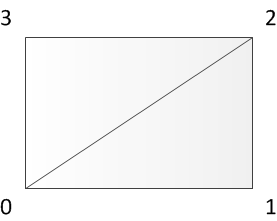
Text geometry and winding
All the glyphs requested at runtime are stored in a glyph map. The glyph map is implemented as a texture atlas. Each vertex of the text geometry provides texture coordinates that will project the glyph bitmap onto the geometry. For each rasterized pixel there is a lookup in the glyph texture. The color provided using the input object will be used for the red, green and blue channels. The content of the glyph map is used for the alpha channel. This way glyphs can be rasterized using the color depth of the glyph map using a color provided by the user.
The following diagram depicts the storage of the bitmap data in a texture atlas with the according geometry, drawn for the glyph. The font engine delivers a monochrome bitmap of the requested glyph. This data is packed into a texture atlas with an additional transparent border of one pixel on each side. Thus, a glyph of size 4x4 takes 6x6 texel place in the texture atlas. The vertices of the drawn geometry are centered into this transparent border texels, so the size of the drawn quad is 5x5 for the given example. The vertex positions are also centered to the midpoint of screen pixels, unless there is no additional transformation, and an orthographic projection is used. That way, each pixel will result in exactly the original transparency value, computed by the font engine. This is also true, when bilinear filtering is active. Bilinear filtering should be activated for rotated or scaled text, to achieve good rendering quality. The one pixel border is needed for the case, when the glyph bitmap is filtered.
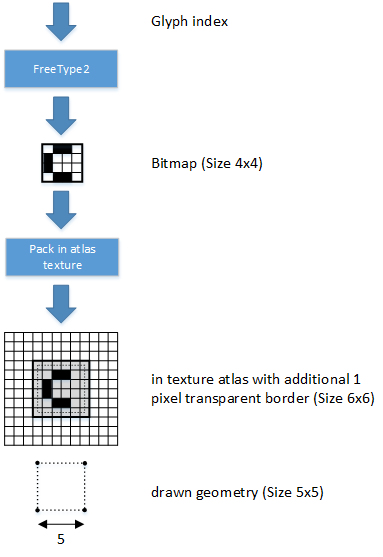
Glyph in texture atlas with according drawn geometry
The picture below depicts the difference of an unscaled glyph versus the same glyph beeing scaled largely by a scale factor. The example glyph consists of 2x2 black texels. When it is rendered unscaled to the screen - shown on left side - it will exactly take 2x2 pixels space. The half pixel transparent border has no influence here. In contrast on right side, when a scale factor <i>f</i> is applied to blow up the glyph’s geometry, the linear gradient between texels become visible in rendering, and now the half texel transparent border will also become visible. The rendering of the glyph takes 3x3 multiplied by the scale factor <i>f</i> pixels on screen.
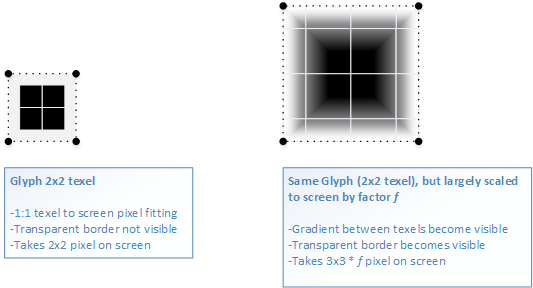
Unscaled (Screen fitting) glyph versus scaled glyph
Beside the bitmap data, each glyph has additional metric information (bearing, size and advance), that is needed to place the glyph at the right position. The following picture shows the three glyphs for the string “yes”. The geometry generation starts for the first glyph, with the so called current pen position in the origin (0,0). The bearing vector of the glyph is added to the current pen position, as shown by the red arrows. This gives the lower left corner of the positioned glyph. The size of the glyph is the horizontal and vertical number of pixels, which are stored for that glyph in the texture atlas. As described above, the final geometry is offseted by 0.5 pixel in x and y direction, because of the additional 1 pixel transparent border around the glyph. After positioning one glyph, it’s advance value is added to the current pen position for placing the next glyph.
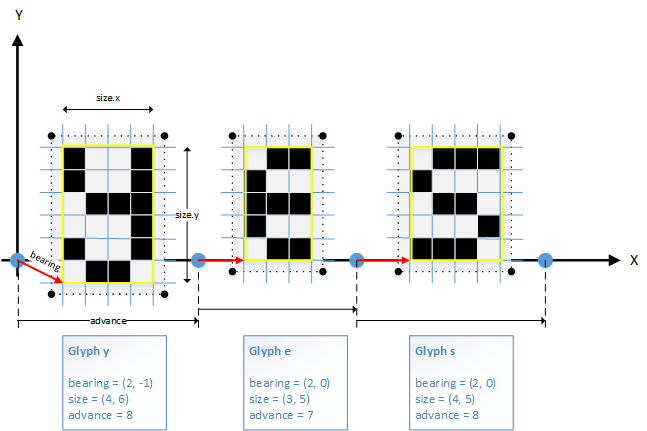
Using the metrics for positioning glyphs
Text Shaders
In order to create a renderable mesh representing text, the mesh has to have a valid shader. User needs to provide a RAMSES effect that will be assigned to both Geometry and Appearance created by the text logic. The effect has to have semantics assigned to various uniform and attribute inputs so that the text logic knows where to bind necessary inputs like vertices, texture coordinates and sampler with glyph texture.
These are the semantics required for text:
EEffectAttributeSemantic::TextPositions (attribute of type vec2)
EEffectAttributeSemantic::TextTextureCoordinates (attribute of type vec2)
EEffectUniformSemantic::TextTexture (uniform of type sampler2D)
Check the text example to see typical text shader usage, generally shader can have any logic and can be customized to fit user’s needs. Similarily Appearance’s properties can be arbitrary but typically use alpha blending and no depth test if used as 2D overlay.
The Renderer component
Renderers act as content consumers, they can subscribe to content changes from clients and show it on screen. Renderers cannot change scene content directly, but can control when a scene is shown/hidden, in special cases can render offscreen buffers and link certain types of data across scenes.
RendererAPI
The RAMSES Renderer API allows to
create displays and offscreen buffers
control rendering states of scenes
link data between scenes
control render looping, timing, limits
access/control to the system compositor controller
Display Management
The renderer setup consists of a ramses::RamsesRenderer object and a set of displays belonging to it.
Every display can be configured through an individual ramses::DisplayConfig.
Scene control and scene states
A renderer offers a separate API to control the scene states, the RendererSceneControl. It can be obtained
using the ramses::RamsesRenderer::getSceneControlAPI() function.
Renderer Scene Control
Graphical content (a ramses::Scene provided from ramses::RamsesClient) is always in a certain state,
a state in the context of single ramses::RamsesRenderer instance.
Typically the desired state to reach is that the scene is rendered, however the scene has to go through
several other states to reach that:
scene is published, i.e. client announced that the scene can be requested from one or more renderers
renderer requests scene and its data, any change to scene data will be transferred to renderer
renderer maps scene to a display, assigns to framebuffer or offscreen buffer and uploads all scene resources
renderer starts to render scene
These states and other parameters can be set/requested using ramses::RendererSceneControl, see its documentation
for more details.
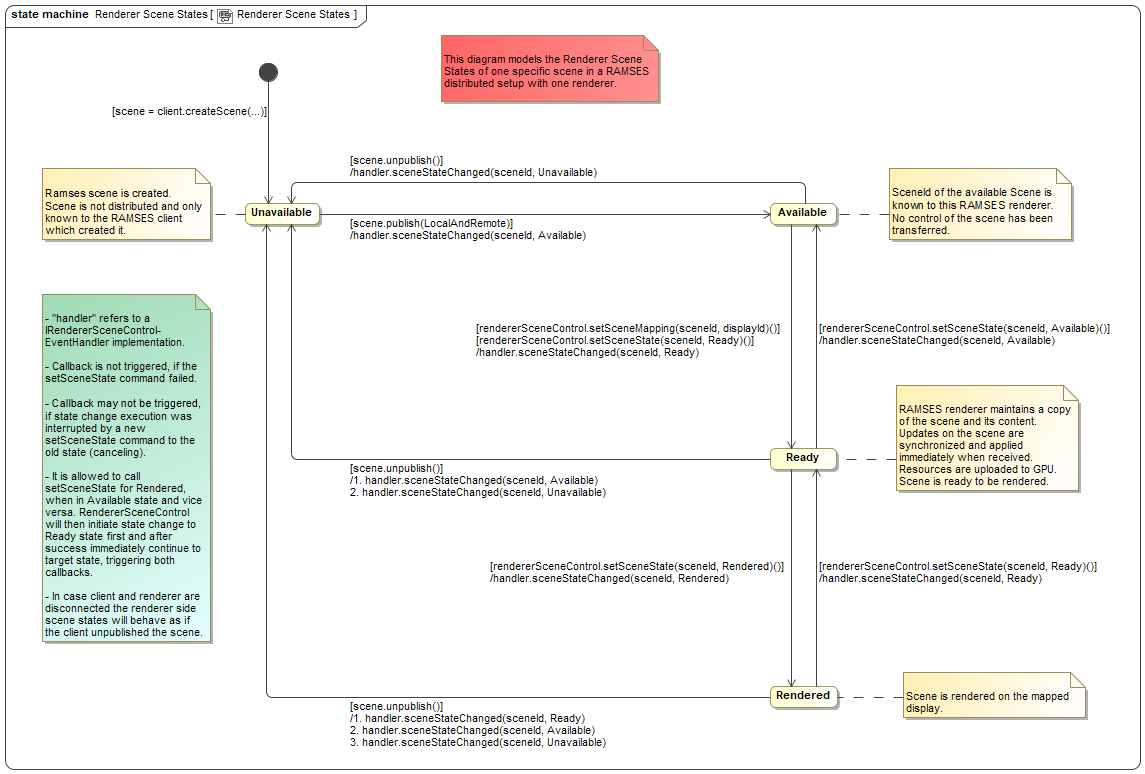
Data Linking
In order to achieve scene interaction, it is possible to attach scene content of one scene to scene content of another scene. There are several types of data links, all of them have a data provider on one side and one or more consumers on the other side, the consumers then use the data of the provider.
Provider and consumer data is tagged with an ID on RAMSES client scene side and then can be linked on RAMSES renderer side. Scenes with provider and consumer data can come from different clients that do not have to know each other (only the tagged data IDs are globally known) and once the scenes are subscribed (mapped in case of texture linking) on renderer they can be linked together.
Data links are dynamic so any change to provider data (including animations) will be reflected to all its consumers.
Data links of any kind can only be established if provider scene and consumer scene are mapped to the
same display via ramses::RendererSceneControl::setSceneMapping().
Transformation Linking
For transformation data linking the provided scene content is the transformation matrix of a
scenegraph node (any ramses::Node typed object in scene),
which can be consumed by node(s) of consumer scene(s).
The consumer node (and all its children in scenegraph topology) will transform using
the provider node’s transformation.
DataObject Linking
ramses::DataObject can be used to set values of ramses::Appearance uniforms or
ramses::Camera parameters which can also be linked across scenes.
As long as data type is matched a data value stored in a ramses::DataObject of one scene can
be used as uniform input of an ramses::Appearance in another scene.
Texture Linking
Texture resources can be tagged as data providers and can be consumed in another scene by ramses::TextureSampler.
Renderer API calls & Events
Renderer API calls are handled asynchronously. This means that the result or information about success
of the requested renderer operation is not available
immediately after the API call.
The result of the API call will be delivered via renderer events. The ramses::RamsesRenderer and
ramses::RendererSceneControl each offer its own event dispatching mechanism,
such that an object implementing ramses::IRendererEventHandler / ramses::IRendererSceneControlEventHandler
interface can handle and process renderer/scene control events.
Events generated as a result of a ramses::RamsesRenderer or ramses::RendererSceneControl
API call can have different statuses reported:
OK: the Renderer API call was successfulFAIL: the Renderer API call was unsuccessful, check logs for error messageINDIRECT: the event was generated as consequence of another event from Ramses client side (e.g. scene unpublish or disconnect) or some other internal event- A special case of status report is ‘no status’ - scene state change requests (
ramses::RendererSceneControl::setSceneState()) might not generate any eventin case that a condition to reach desired state is not met (e.g. scene not published, display not created, etc.). Note that these will not timeout explicitly,it is responsibility of the application to implement timeout logic.
Renderer API transactions
The ramses::RamsesRenderer and ramses::RendererSceneControl calls are queued and
only executed when committed. To commit a batch of calls use ramses::RamsesRenderer::flush()
and ramses::RendererSceneControl::flush() respectively. All calls since the last flush
will then be executed together (preserving order) in the very next
renderer update loop (either ramses::RamsesRenderer::doOneLoop() or in render thread).
Offscreen Buffers
When a RAMSES Client Scene is subscribed, mapped to display and shown, RAMSES Renderer renders it directly into the display’s framebuffer. This default behaviour can be modified by assigning the scene to an offscreen buffer using Renderer API, scene will then not be rendered directly to display’s framebuffer anymore but to a buffer that can be used as texture input in another scene.
Using Offscreen Buffers
All scenes that are supposed to be assigned to an offscreen buffer have to be mapped to the same display where the offscreen buffer was created. There can be multiple scenes rendered to the same offscreen buffer but a scene can be rendered to exactly one buffer or framebuffer.
An offscreen buffer can then be linked to another scene’s (consumer scene) texture input similar to Texture Data Linking. Consumer scene where the offscreen buffer is to be used as texture has to have a Texture Consumer which is in fact a TextureSampler with a Data Consumer Id. Consumer scene has to also be mapped to the same display as the offscreen buffer (and scenes rendered into it).
Scene To Offscreen Buffer Assignment Rules
Scene has to be mapped to the same display where offscreen buffer was created.
If the assigned scene is hidden or unpublished by the client it stops being rendered into the offscreen buffer.
If the assigned scene is unmapped from display, it is unassigned from its offscreen buffer. Next time the scene is mapped to a display it will be assigned to the display’s framebuffer (even if it is the same display as before).
Scene can be reassigned to another offscreen buffer or display’s framebuffer, then it stops being rendered into the original offscreen buffer.
Offscreen buffer cannot be destroyed if there are any scene assigned to it.
Offscreen Buffer To Consumer Scene Linking Rules
These rules are analogical to scene to scene Texture Data Linking.
The consumer scene has to be mapped to the same display where the linked offscreen buffer was created.
The consumer scene has to have a Texture Consumer which is not linked to any provider or another offscreen buffer.
When a linked consumer scene is unmapped from its display, the offscreen buffer is unlinked. Next time the scene is mapped to a display it will have no links (even if it is the same display as before).
If an offscreen buffer is destroyed, it is unlinked from any linked scenes. Previously linked consumer scene(s) will then use their original texture.
Clearing Rules
Clearing of offscreen buffers is currently implicit and cannot be controlled by user explicitly. An offscreen buffer will be cleared at the beginning of every frame only if there is any scene mapped to it. This means that if a single scene that is mapped to the offscreen buffer gets unmapped for any of the reasons mentioned above, the offscreen buffer will not be cleared until there is another scene assigned to it. However the offscreen buffer would be cleared if it has hidden scenes assigned to it.
Render Order
RAMSES Renderer allows user to define scene render order when mapping a scene to a display. Assigning a scene to offscreen buffer or linking an offscreen buffer to a consumer scene does not affect the render order of any of the scenes involved. It is user’s responsibility to define the render order so that desired result is achieved, this in most cases means to render the scene(s) assigned to an offscreen buffer before the consumer scene using the contents of the offscreen buffer.
ContentExpiration
The Daemon component
In TCP-based a network deployment, the daemon “broadcasts” the existence of clients and renderers to each other (providers and consumers of scenes, respectively). This allows clients and renderers connected to the same daemon to find each other. After this initial discovery the communication is via a direct connection between to the clients and renderers.
Other communication middlewares normally include a discovery mechanism already and make the ramses daemon superfluous.
In a purely local rendering setup where the only clients and renderers are within a single process the daemon is normally also not needed.
Component deployment and communication
The three RAMSES components (client, renderer, daemon) can all live in the same process, or can be deployed across different processes or even different hardware units. Depending on the concrete deployment, Ramses will use different communication channels to send data from the client to the renderer. If the client and renderer are in the same process, they will not use any network communication, but will exchange data over local memory. If the client and renderer are not in the same process, the connection will be established over a network protocol (TCP by default).
Advanced concepts
Ramses offers some additional features and concepts which are specific to distributed rendering and designed to make it easier to share, link, composit visually demanding content in a environment with strict timing and performance constraints.
Compositing
In addition to distributing 3D scenes, Ramses can composite other OpenGL native applications using the Wayland protocol. The Wayland protocol enables efficient compositing of 2D images with zero copy (i.e. no pixel buffers are copied throughout the system unless when directly rendered to the screen). In the RAMSES case, it is called “embedded compositing” because the RAMSES renderer is itself composited into the system compositor. Thus, applications which connect to RAMSES via Wayland are “embedded” into the RAMSES renderer, which is in turn “embedded” into the system compositor final rendering.
Introduction
Configuration
Embedded Compositing API
Example
List of all examples
Examples